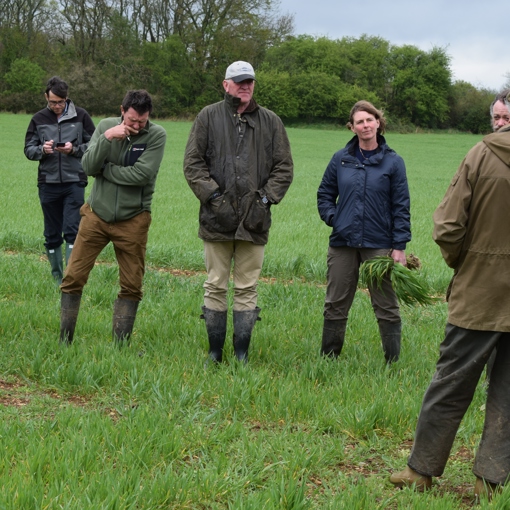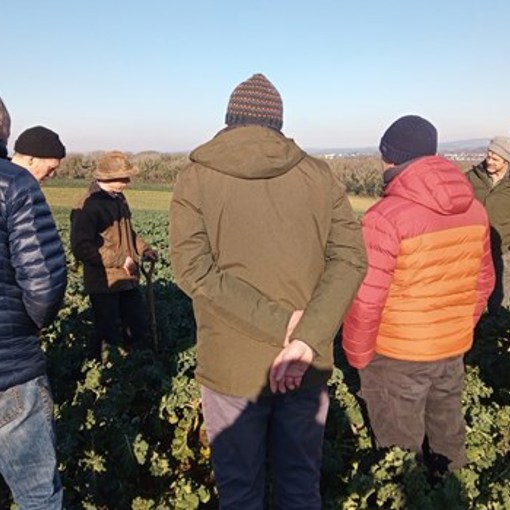Many organic farmers rely on conventional varieties bred for high inputs, with the twin goals of yield and disease resistance prized above all else. This approach makes sense for the environments these crops will generally be grown. However, the problem for most organic farmers is that the traits of nutrient scavenging and weed suppression are ignored in the face of a full mineral fertiliser and herbicide regimes.

The typical organic arable farmer finds weeds and soil fertility, or at least nitrogen availability, the biggest agronomic challenge with the varieties on offer generally not considered fit for purpose. Varietal choice is one of the few inputs an organic farmer has influence over during the arable cropping cycle so the opportunity to investigate alternatives is currently being lost. Before now, variety testing has only been carried out under conventional farming conditions.
The question is, are there better varieties out there, waiting to be discovered?
Through the Innovative Farmers programme, a group of organic farmers in the Cotswolds decided to take the matter into their own hands. They tested the genotypes on a commercial organic farm to evaluate the genetics available and get a better idea of performance to inform future varietal choice.
How the field lab was set up
The first part of this field lab involved a plot trial. This took place on Charles Hunter Smart’s Bradwell Grove, a farm based on shallow, typical Cotswold brash land. It consisted of a randomised complete block design of 22 varieties in small plots, replicated 3 times. However, because the plot trial provides information from just one environment, using plot equipment and under only one management regime, farmers also grew selected varieties at a field scale using their own commercial equipment and management, including mechanical weeding. This gave each farmer a better understanding of on farm commercial performance which was relevant on their own farms. The approach gave farmers the opportunity to look for alternatives to their current wheat varieties, with the plot trials used to provide a broad varietal comparison, including some novel genotypes, and more general information on traits.
The field lab will hopefully allow identification and subsequent testing of interesting genotypes to perhaps bring novel lines into commercial organic production. Testing a restricted number of varieties at a field scale with a network of farmers, whilst maintaining a reference plot trial is by far the best methodology from which to draw robust conclusions about varietal performance in organic systems.

The results from the field lab
Typical agronomic data such as height, disease incidence and ear number were collected from the plots. Ground cover, height and growth habit were also recorded in late winter and early spring at a time when competition with weeds and for resources is important. Assessment in March and April provided data on changes in these traits providing a proxy for spring vigour, with those varieties growing more quickly, growing taller and covering the ground faster deemed to be more vigorous.
On initial investigation, the only trait that looked to be linked to yield was growth habit, with the more prostrate (flatter to the ground) generally being higher yielding. Previous work on traits under organic husbandry has shown a strong link between crop ground cover and yield. A full report on the traits measured and the possible correlations to yield and quality will be available soon through the find a field lab page.
Different wheat for different organic farm management systems
Two field lab meetings took place with farmers selecting their favourite varieties based on their own selection parameters (visual assessment). It was an interesting exercise to see and hear the farmers discussing and picking their preferred varieties. At early stem extension the farmers seemed interested in traits like ground cover and growth habit and selected both Montana and Mv Fredericia. Interestingly, these two varieties were selected for different reasons; with Fredericia selected for being tall and erect, with good vigour and a suitability for interrow hoeing, while Montana was chosen for it’s even canopy, high ground cover, with a slightly more prostrate growth habit and lack of disease.
This does raise an interesting point about organic ideotypes and suitable traits, given that so much depends on the management of the crop, this provides further evidence that one size does not fit all. Tall varieties generally are favoured for weed suppression but if the farm uses a weed surfer, this may not be a desirable trait. Likewise, prostrate varieties may not be as suitable for inter-row hoeing. Of course, this was the main working hypothesis of the ORC Wakelyns population, that it could offer relevant traits given natural selection on the farm over time favouring varieties which survived best under the particular conditions on the farm.
At the late season meeting, the farmers selected Hallfreda, a near market line from a Swedish breeder Lantmannen SW. The variety was very green, and free of disease at this late stage of the season with a good canopy which appealed to the farmers. We will test this variety for a second year to confirm its organic credentials, and with the bonus of bunt tolerance, it could be a good choice for organic farmers in the future.
The yield data
The varieties averaged 3.6t/ha in 2019, with well-known and widely grown varieties like Evolution, Costello and Revelation yielding best. Siskin and Crispin have again performed well and continue to show consistently high yields across the environments they are tested through the Liveseed variety trial network. Yield results for Hallfreda and Mortimer are interesting.
This is the second year that Mortimer has done well and highlights one of the difficulties faced by the organic sector, as even a variety showing good performance under organic husbandry, must also perform under conventional conditions to be maintained as commercially available. This variety was being carried by Agrii in the UK in 2018 but was dropped due to a lack of interest from the non - organic sector. Along with Hallfreda it could have potential for the UK organic sector.

What next for the research?
Until UK-focused organic breeding programmes are set up, organic farmers will be forced to continue to rely on varieties which perform well in high input settings. Research to identify varieties currently overlooked by the conventional sector remains highly relevant to farmers looking to reduce inputs. Identifying and then testing novel varieties on a field scale remains the goal of the field lab, with one farm interested in growing Mortimer at scale.
Experiments with continental organic varieties showed promise in terms of desirable traits but susceptibility to UK pathogens limited performance. While a risk, it’s not a given that continental varieties will succumb to disease so more organic continental varieties will be tested in the plots again next year from biodynamic breeder Peter Kunz. The performance of Hallfreda this year shows that some continental varieties can do well in the UK. The farmers who grew Ehogold were really impressed by the variety and its traits, until yellow rust took hold, severely effecting grain filling and hence yield.
Next year's trial has 14 farms taking part with the chosen control being Siskin and the bridging varieties being Alabaster, YQ, Crispin and Revelation. Hopefully the farmers in the network see that as a small community, working together to test the varieties across their farms, is the best way to provide the most useful information for the whole organic arable sector. This is where the link to a wider initiative comes into play, with the EU Liveseed project helping to structure a farm-focused variety testing model.
Contact us get involved
To keep informed of how this field lab and others are progressing sign up to our newsletter below.
Related news

08 June 2021
Plant breeding for low input farms
Organic and low input farmers disadvantaged by current wheat breeding system

30 January 2023
Min till and cover crops
Strip-till in horticulture: Farmers and growers collaborate to solve unanswered questions

17 January 2023
On farm innovation